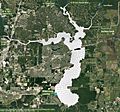Lake Houston facts for kids
Quick facts for kids Lake Houston |
|
|---|---|
| Location | 15 miles (24 km) northeast of downtown Houston, Texas |
| Coordinates | 29°57.53′N 95°8.93′W / 29.95883°N 95.14883°W |
| Type | Municipal water reservoir |
| Primary inflows | west fork of the San Jacinto River |
| Primary outflows | San Jacinto River |
| Basin countries | United States |
| Surface area | 11,854 acres (4,797 ha) |
| Max. depth | 45 ft (14 m) |
| Water volume | 160,000 acre⋅ft (0.20 km3) |
| Surface elevation | 44 ft (13 m) |
Lake Houston is a reservoir on the San Jacinto River, 15 miles (24 km) northeast of downtown Houston, Texas, United States. The reservoir is the primary municipal water supply for the city of Houston.
Contents
Location and creation
Situated between the communities of Kingwood, Atascocita and Humble on the west bank, Sheldon on the south, and Crosby and Huffman on the east. An earthen dam spans a portion of the southern bank along Dwight D. Eisenhower Park.
The reservoir was created in 1953 when the City of Houston built the dam to impound a reservoir to replace Sheldon Lake, then the primary source of water for the city. The city sold Sheldon Lake to the Texas Parks and Wildlife Department for use as a waterfowl sanctuary and public fishing site.
The City of Houston annexed the Lake Houston area and a 22.5 miles (36.2 km) canal in 1956.
Fish and plant populations
Lake Houston has been stocked with species of fish intended to improve the utility of the reservoir for recreational fishing. Fish present in Lake Houston include catfish, largemouth bass, white crappie, and bluegill.
Recreational uses
Boating and fishing are both popular recreational uses of the lake. At the northern end of the lake, Lake Houston Wilderness Park has rental cabins, facilities for camping, a kayak launch and trails for hiking and biking.
- Lake Houston from the Handbook of Texas Online
Images for kids
See also
 In Spanish: Lago Houston para niños
In Spanish: Lago Houston para niños




